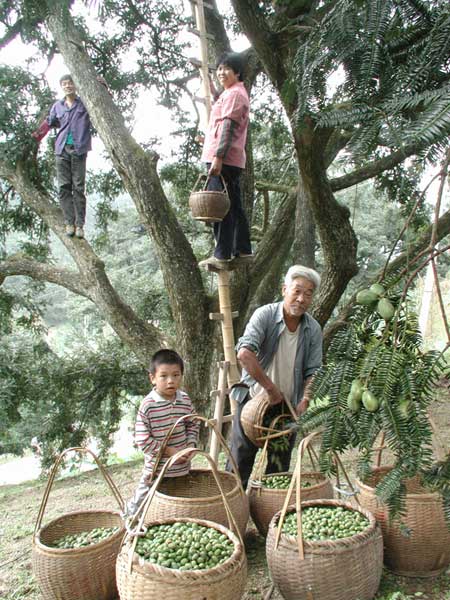 |
|
Local people are picking torreya nuts in the Mount Kuaiji area in Zhejiang province. [Photo provided to China Daily] |
Shelter of ecosystem
The torreya trees are also a mainstay of the ecosystem in Mount Kuaiji, where land is scarce and typhoons and floods are frequent. Along with the trailing terraced fields, tea gardens and fish-scale pits, they help protect the unique ecosystem.
"Terraced fields by themselves lead to soil erosion in the mountains. So we grow trees as well, because they not only generate incomes, they also prevent natural disasters," says Zhang Xiaojun, deputy secretary general of the municipal government of Shaoxing.
"There is a saying here that raising a torreya tree is sometimes better than raising a son," says Tong, the engineer, "as the trees will support you throughout your life time no matter what. So the torreya farmers care for them just like their own children."
Bearing fruit
It takes 15 years before a torreya tree becomes productive, and it takes 18 months for the fruits to mature. Every September, the whole village will work around the clock for a month to pick and process the harvest.
Last year, 80 percent of the annual per capita income in Zhaojiazhen, more than 8,000 yuan ($1,306), came from the torreya trees. The total output of fruit was 1,313 tons, with a value of 625 million yuan ($101 million).
Because the torreya trees are usually very tall and covered with moss, local people have invented tools like the "centipede ladder" and hanging bamboo baskets for the picking season. However, accidents still happen from time to time, making the harvest a time for prayers.
The process of turning the fresh torreya fruit into tasty nuts takes 11 steps, including peeling, washing, drying and stir-frying. It is said that the torreya nuts fried by local farmers taste the best because they know how to control the heat and how long they need to be cooked based on the smell of the torreya. Since the 1980s, the annual production of torreya nuts has increased from 50 tons to more than 1,000 tons.
For more Eco-China, here
|
|
|
|
|
|
|
|
